Human vision may be limited to a specific range of wavelengths, but that doesn't mean we'll never understand the full complexity of light in our Universe.
Instruments can peer into the cosmos in regimes that are otherwise invisible to our eyes, showing us not just the dynamics of the stars, but their absolutely awe-inspiring beauty. This is what we see in a new collection of images from the Chandra X-ray Observatory that combines its data with other instruments for spectacular multi-wavelength views.
Because different wavelengths of light have different energies, these images can show us the dynamics of cosmic objects from low energy to high. This can help scientists unravel the mechanisms behind the glorious light-shows.
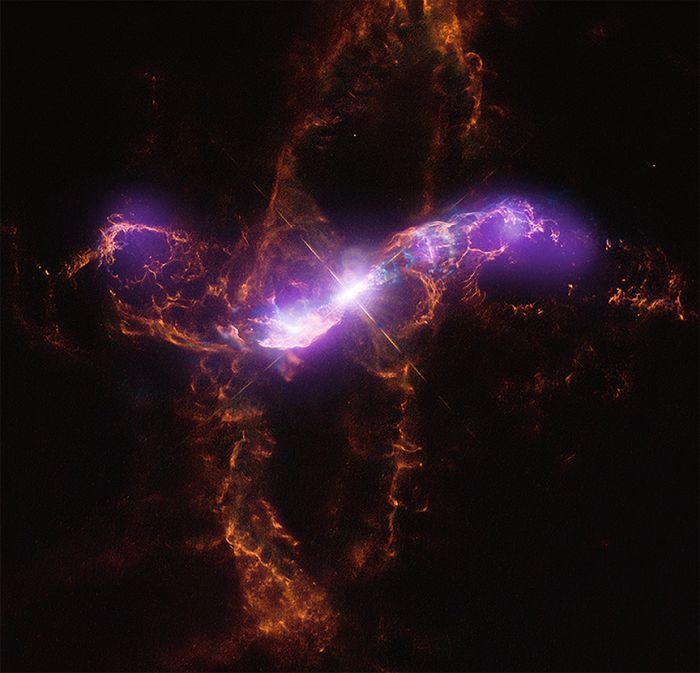 R Aquarii. (X-ray: NASA/CXC/SAO/R. Montez et al.; Optical: NASA/ESA/STScI)
R Aquarii. (X-ray: NASA/CXC/SAO/R. Montez et al.; Optical: NASA/ESA/STScI)
R Aquarii, seen here in X-ray from Chandra (purple) and near-infrared and optical from the Hubble Space Telescope (red and blue) is a pair of stars locked in a violent dance of death 650 light-years from Earth. One of the stars is a red giant, known as a Mira variable star, at the very end of its lifespan. Stars of this kind have already lost at least half their material, and as they pulsate, they reach a brightness 1,000 times that of the Sun.
The other star is a white dwarf – a 'dead' star that has exhausted its nuclear fuel – and also has a lot going on. As the red giant ejects material, the white dwarf slurps it up. The material it devours from the red giant accumulates on its surface, occasionally triggering an enormous thermonuclear explosion that blasts the material out into space.
This violent interaction is creating clouds of dust and gas in a nebula around the binary, churned up by their gravitational interactions and explosive shock waves.
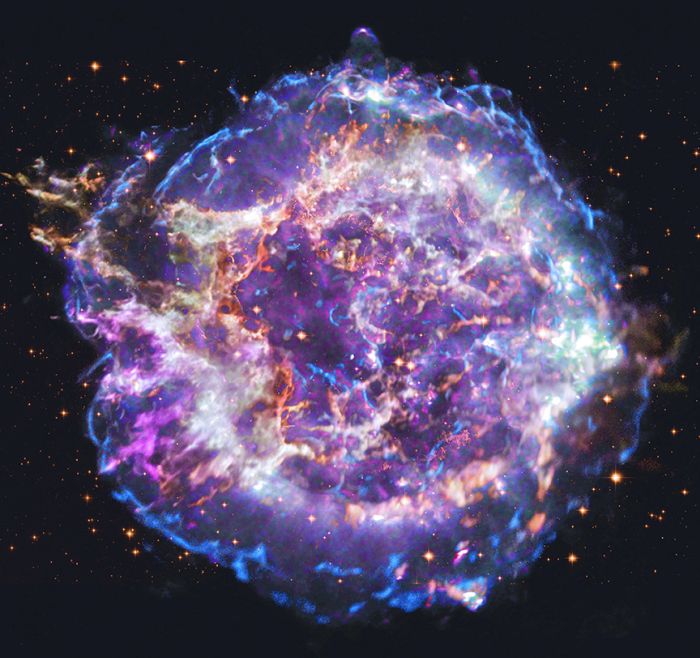 Cassiopeia A. (NASA/CXC/SAO; Optical: NASA/STScI; Radio: NSF/NRAO/VLA)
Cassiopeia A. (NASA/CXC/SAO; Optical: NASA/STScI; Radio: NSF/NRAO/VLA)
Cassiopeia A, located 11,000 light-years away, is one of the most famous and well-studied objects in the Milky Way. It's what we call a supernova remnant – what's left after a massive star has gone kaboom. Here, X-ray data from Chandra are combined with radio data from the Karl Jansky Very Large Array (dark purple, blue, and white) and optical data from Hubble (orange).
These different wavelengths can reveal what's actually happening in the expanding cloud, consisting of the guts of a dead star. From these combined data, scientists are able to identify different elements within the explosion. The Chandra data alone revealed that the exploding star blasted off 10,000 Earth masses of sulfur; 20,000 Earth masses of silicon; 70,000 Earth masses of iron; and 1 million Earth masses of oxygen.
This is important information, because it tells us what elements were produced in the star when it died. In turn, scientists can use these data to learn more about the star when it was still burning, to make predictions about similar stars in our galaxy.
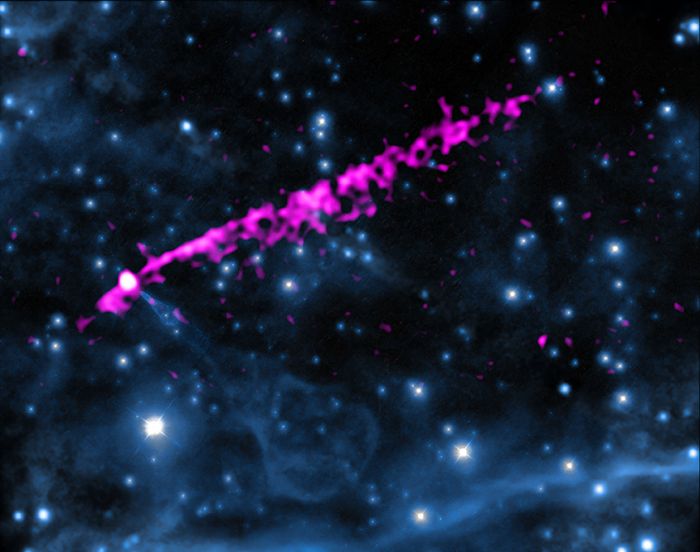 ( NASA/CXC/SAO; Optical: NASA/STScI & Palomar Observatory 5-m Hale Telescope)
( NASA/CXC/SAO; Optical: NASA/STScI & Palomar Observatory 5-m Hale Telescope)
This image shows two different effects produced by a single dead star called PSR B2224+65. The pink streak is X-ray emission ejected from the poles of a type of neutron star called a pulsar. That's the collapsed core of a dead massive star that emits pulsing radiation as it rotates.
That would be interesting enough, but PSR B2224+65 is also what we call a runaway star; it's speeding through the galaxy after being punted into space at a speed of around 1,600 kilometers, or 1,000 miles, per second. That motion has created a wake in the interstellar medium; you can see it in the lower left of the image in optical wavelengths (blue). Because it looks uncannily like a guitar, astronomers have named it the Guitar Nebula.
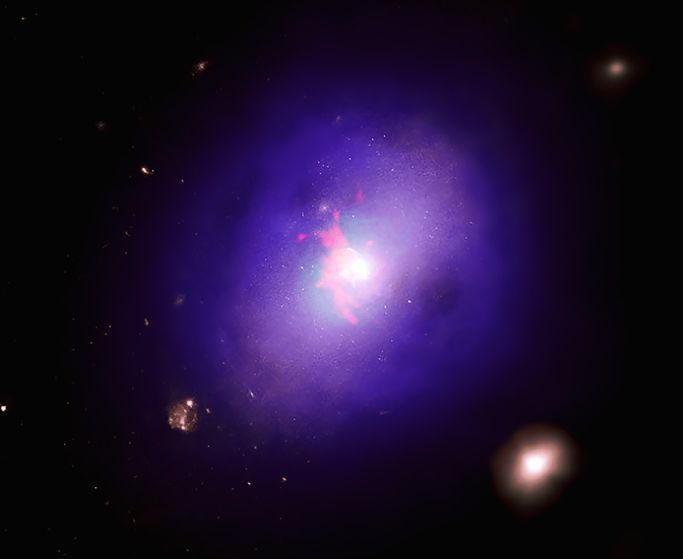 Abell 2597. (NASA/CXC/SAO/G. Tremblay et al.; Optical: DSS; H-Alpha: LCO/IMACS/MMTF)
Abell 2597. (NASA/CXC/SAO/G. Tremblay et al.; Optical: DSS; H-Alpha: LCO/IMACS/MMTF)
Some of the biggest collections of objects in the Universe are galaxy clusters. These clusters can contain thousands of galaxies, bound together by, and interacting via, gravity. This cluster is Abell 2597, roughly a billion light-years away, and multi-wavelength astronomy has helped scientists learn more about the behavior of the supermassive black hole in its central galaxy.
Just a few years ago, astronomers saw evidence that this behemoth is blasting out molecular gas as it gravitationally accretes material. This molecular gas is then falling into the black hole, and feeding the cycle anew. It's a phenomenon known as a "fountain". The hot outflow and cold infall were observed using two different instruments; then X-ray data from Chandra revealed that they're part of the same process.
This image above shows the cluster in X-rays (blue) from Chandra, and optical from the Digitized Sky Survey (orange) and Las Campanas Observatory (red).
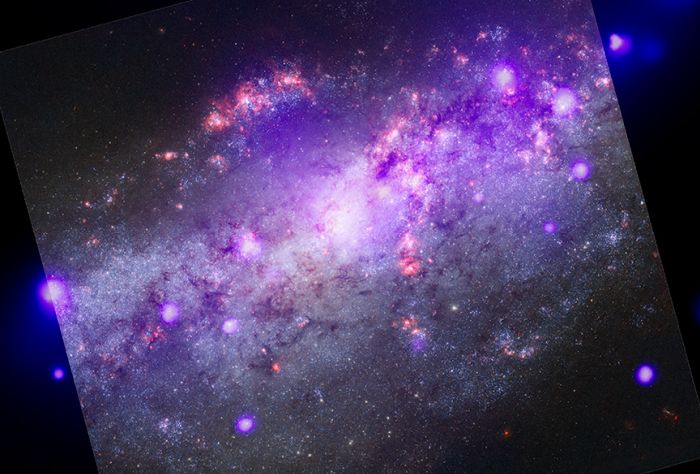 NGC 4490, the Cocoon Galaxy. (X-ray: NASA/CXC/SAO; Optical: NASA/STScI)
NGC 4490, the Cocoon Galaxy. (X-ray: NASA/CXC/SAO; Optical: NASA/STScI)
Finally, this image shows two galaxies that have merged. It's called NGC 4490, or the Cocoon Galaxy, and, fascinatingly, multi-wavelength astronomy revealed a secret in its core. It has not one, but two supermassive black holes, one of which is only visible in optical data, and the other can only be seen in radio and infrared. Both had been seen separately, but it took years for astronomers to put the two together.
This double nucleus is the result of that merger process; each of the two galaxies had its own supermassive black hole. Eventually, the two black holes will also likely merge, resulting in one much bigger monster.
This image combines X-ray data from Chandra (purple) and optical data from Hubble (red, green and blue) to show the results of another close galactic encounter. NGC 4490 had a hit-and-run with a smaller galaxy, NGC 4485, which perturbed the gas and triggered waves of star formation, seen here in red.
You can download larger versions of these images on the Chandra website. Cover image credit: X-ray: NASA/CXC/SAO; Optical: NASA/STScI, Palomar Observatory, DSS; Radio: NSF/NRAO/VLA; H-Alpha: LCO/IMACS/MMTF
#Space | https://sciencespies.com/space/breathtaking-new-chandra-pics-show-cosmic-objects-like-youve-never-seen-them-before/
No comments:
Post a Comment